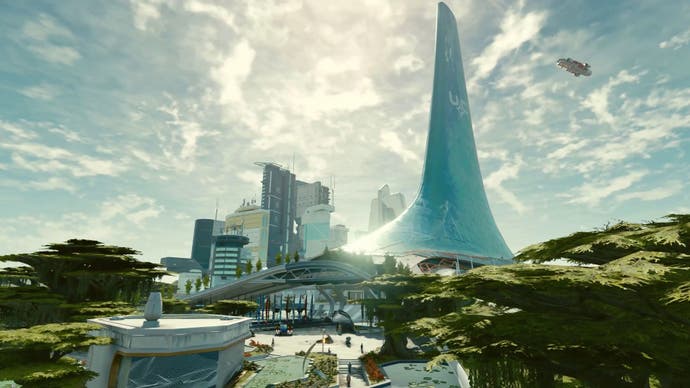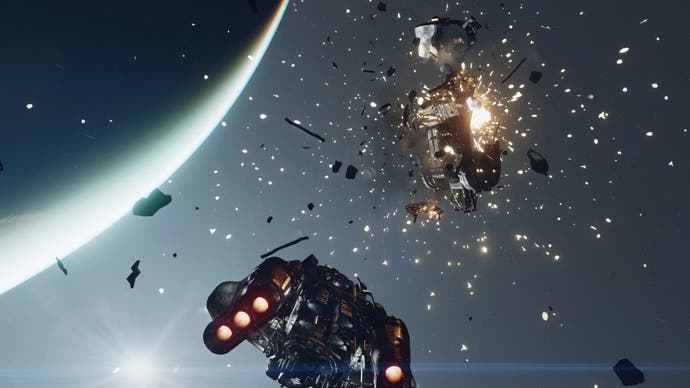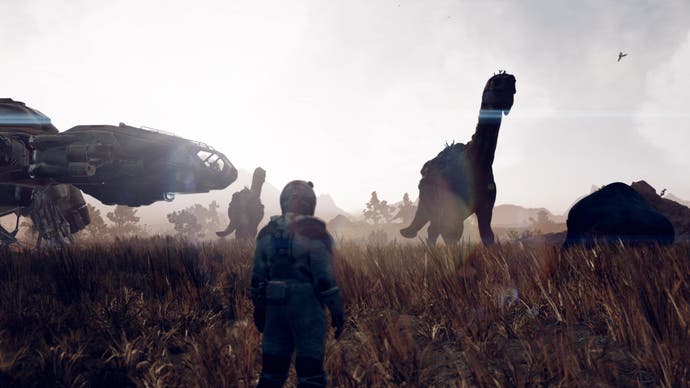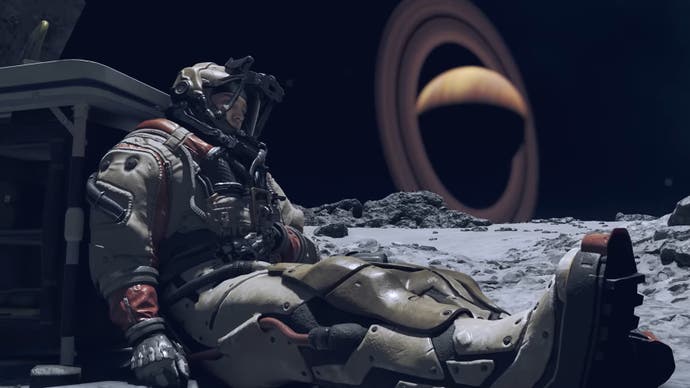How realistic is Starfield? We ask the European Space Agency
The sound of science.
Did you know you can change the direction an asteroid is travelling in by painting one side of it white and one side of it black? Or that astronauts on the International Space Station experience sunrise and sunset 16 times a day? Now that I think about it, it seems obvious, but it never crossed my mind until the European Space Agency's Mr Emmet Fletcher enlightened me.
Fletcher is the ESA's head of branding and partnerships. He has spent almost 30 years working on "literally hundreds" of space-related projects, including ESA's Rosetta mission. Not only was this mission the first to rendezvous with a comet, it was also the first to follow a comet on its orbit around the Sun, and the first to deploy a lander to a comet's surface. He is also, as it happens, rather partial to a video game or two, starting back on the BBC Micro and having since clocked up numerous hours in titles such as Juno, Kerbal Space Program and Elite Dangerous (a game he calls "stunning").
Earlier this week, I sat down with Fletcher over Teams to talk about Starfield, and space games in general. We turned over numerous topics, ranging from how the International Space Station will be disposed of (they are going to re-enter it, so it will be burnt up in the atmosphere), all the way to James Bond and Bruce Willis. In the end though, our conversation revolved around two key points - What does entertainment media get right about space? And, more interestingly, what does it get wrong?
We started by taking a closer look at Bethesda's Starfield timeline, which states that humans will arrive on Mars in 2050. So, in only 27 years. This, Fletcher told me, is "ambitious", but certainly not impossible.
"It's an interesting schedule. I mean, quite recently, some of the schedules were around that for Mars, but Mars is difficult. I mean, Mars is really tough," he said, stating that any missions to the red planet are a different situation to the monumental race to the moon of the 1960's.

"[That was] a 'superpower versus superpower' thing. They could invest huge amounts of their domestic product to do their moonshots," Fletcher noted. "The world has changed... and a lot of the developments in the space industry today are driven on commercial, and [ESA] is still driven on the science side. I mean, that's the heart of the agency."
Fletcher explained that, until quite recently, he would have classed gradually getting humans on Mars as "challenging". However, he also reflected on how far we have come with flight in general over the last century. After all, the Wright brothers' first powered flight was in 1903, only 120 years ago. And now, we have rockets and space exploration in what is a relatively short amount of time.
"And look at the first computer! If we look at that, at the end of the Second World War, we had the Colossus, which were these basically room size things which now compute less than, I don't know, an aura ring or much less than my watch," he continued. "So, when we think about that, who knows what will happen in the future, what breakthroughs will happen?
"We're still doing things that you wouldn't even think that you could do. I mean, we have a mission going up in the next 10 years, which will look at the atmospheres of planets around other stars... so we can see if there's oxygen on a planet around another star, like 70/80/100 light years away. And you would think, 'nah, I don't think we could do that'. Well, the scientists are going, 'Yeah, we could do that'. So that's the kind of thing which we wouldn't think was possible if we just say it now, but yeah, it's possible... There are advances being made all the time and you never know where the next breakthrough is gonna come through."
So while Fletcher said he still believes 2050 is an "ambitious" timeline for humans on Mars, he would "never like to say no". That said, Starfield has laid down a pretty "tight schedule" for it all, he laughed.

But, let's say we did make it up there, and our timeline continued on in the way Bethesda has stated. Would we be able to actually create settlements on planets such as Mars, and then defend our habitations from invading forces? Starfield has promised multiple colonies to explore, and plenty of things to blow up in space - be they enemy ships or rocky masses of organic matter. Well, it turns out, this would be a very, very bad idea.
First off, Mars would be a pretty terrible planet to live on - it would kill us "very quickly". Yes, there is water, but it is also a very cold and very toxic place, with a lot of radiation.
Mars' soil is "basically oxides of iron, which are not very healthy at all," Fletcher told me. "So, we can do more exploration, but it's not a replacement for Earth. We evolved for Earth." In short, if we ever get to a point where we are seriously considering upping sticks and moving to another planet, we should be asking ourselves how and why we got there.
"We need to make sure that Earth remains friendly to humans," Fletcher said, touching on ESA's own endeavours to be a more environmentally friendly organisation.
"If we screw it up, [Earth's] not gonna be a nice place. And a lot of it is working out where we're screwing up, and what is causing the most damage. [ESA] is producing a lot of data to help identify climate change. So that's one of the things that we are very keen on... The European Space Agency is a peaceful organisation. So we have no military side... the core of everything we are trying to do is science.
"When we look at our Earth observation missions, we have a fleet of satellites in orbit, which are looking at the ice fields, we're looking at the glaciers, we're looking at deforestation, and we are looking at the changing height of the sea. And we see the data - no one is saying climate change is not real - and we are producing the data, which the scientists then take and produce their models."
Fletcher said if we continue on as we are going, Earth will become a very different place. "It might not be very nice for humans, but life will continue because life tries to find a niche - but it might be the cockroaches." Despite how entertainment media often paints it, he says, there "is no planet B".

Back to Starfield, and the world of space colonisation. Fletcher said even if we did find a new planet to make our home on, it would require a huge amount of resources to make possible.
"I mean, if you look at the Dyson Sphere, which is the ultimate artificial way of going off planet, where basically you encircle your entire star with a sphere and you live on the inside of the sphere... then we had, in the 70s, a science fiction thing called Ringworld. So you had a ring around the star and that would increase your habitable volume by millions, but you'd have to dismantle the entire solar system to build it," he said.
"This sort of thing, these huge engineering projects - which for us are like complete fantasy - engineering wise, it's kind of, sort of possible with a few caveats, like space elevators are kind of possible but with a few caveats. And they've been thought about for decades. But are we all gonna live in space? I don't know."
As for fighting and blowing things up, Fletcher said if we were to have a war in space right now, it'd "probably shut off access to space for humanity for the next 300 - 400 years" because of the amount of debris that would be left in its wake.
"If you create a huge cloud of debris, you make [space travel] very difficult or very expensive because you have to take a lot of shielding [to protect your ship]. Your weight is limited. And that means you have less space for people, for example, to get into space," Fletcher explained.
"There were a couple of incidents 10/15 years ago, where there were collisions in space. It was just an accident between two small satellites but they caused debris, which will be up there for the next 200 years.
"So imagine you have an intentional war in space, especially near a planet like Earth, then that could cause a debris belt, which would be very, very, very difficult to solve... when something's moving at five times the speed of a bullet, how are you going to stop it and bring it down? Especially when it's the size of a penny or something?"
Fletcher said this debris - space junk - can be anything from a fleck of paint to a massive 10-ton satellite that doesn't work any more. All of this is in orbit, and generally travelling at seven kilometres per second.
"We develop a spacecraft to withstand impacts of around a centimetre in size, but you know you could lose a satellite from something the size of a pound coin going through a sensitive area," he said. Indeed, the ESA has a hole in one of its Sentinel satellites - and while everyone can see the damage on the camera, they don't know what caused it.
As Fletcher pointed out, objects in space could end up shattering - creating even more debris - if impacted due to all the built up kinetic energy and resulting shockwaves. "So, imagine you have a war in space that is intentionally trying to destroy other elements in space. You're going to create a horrible cloud of debris and it's not going to be good.
"I think before there is a war, everybody would be thinking 'wait a minute, if we do have this war, we are not going to be able to operate in space any more'. So, if you have a faction that depends on its income, or its livelihood or its existence in space, it's going to be a lose/lose situation."

We also discussed what it would be like to actually shoot someone in space. Fletcher said in theory you would be able to do this, as a normal gun doesn't require oxygen to work. However, it would not look exactly as entertainment media often portrays it.
In reality, the person firing the gun would end up going backwards due to the energy produced by the shot. There is also a chance the other person's spacesuit would protect them from the bullet. These suits are designed to shield the wearer from impact strikes, such as those from the aforementioned space debris. And, as already mentioned, this debris is travelling faster than a freshly-fired bullet.
But "you could hit someone and kill them with a gun," Fletcher said, musing it "wouldn't be nice". And, even if the shot itself wouldn't be fatal here on Earth, "any kind of open wound is very serious in space". This is because a person's internal pressure is then only working against the vacuum of space.
"Being shot on Earth is not very nice at all, but being injured this way in space would be disastrous. As I said, the spacesuit has a huge degree of impact protection that would probably act as some kind of protection, but we also need to remember that there are some very sensitive life-support elements mounted on the spacesuit that you don't want to lose when outside the spacecraft," Fletcher explained (although, thankfully astronauts do have patches they can mend nicks in their suits with in a pinch).
All that being said, shooting someone with a regular gun in space would be a real faff for the shooter, given the effort to pull the trigger from atmospheric pressure and the size of the spacesuit's gauntlet. Fletcher recalled wearing a gauntlet to use the actual camera the ESA's astronauts used in space, and called the whole process "tough".
In fact, just manoeuvring around generally in a spacesuit sounds like a bit of an undertaking, with Fletcher revealing it can take roughly six hours (or three hours, if really needed) for an astronaut to get fully kitted up and ready to go. Most of this time is spent ensuring that the oxygen has purged their systems, but there are also all of the checks and double checks required as the suit goes on. Then, the astronauts need to slowly depressurise in the airlock.
"It takes a while. It's not a case of 'Oh look, there they go! Quick - get in the spacesuit! Off I go!' You can't do that, at least not right now," Fletcher laughed. Thankfully, things are a bit quicker on the other side. Getting out of the suit takes a more modest 45 minutes, as the astronauts are going from an unsafe environment and back into a safe one.

Away from the faction wars and dogfights in space, which are evidently far from a good idea, Fletcher also discussed mining colonies with me. While we often see media showing huge mining excursions happening on large planets, complete with settlements and the like, this would not be the most efficient way to harvest ore in space.
"Easier than a planet is an asteroid, and we are already doing a lot of work on that," Fletcher told me when the topic came up. "It's easier to land on an asteroid because it doesn't have as much gravity, whereas on a planet, there is a deeper gravity well. You need a lot of energy to land and a lot of energy to go up again, so you can't take so much of the stuff you are mining.
"But an asteroid? Oh yes! We are doing a lot of work on mining asteroids. You could either mine it in situ out in the asteroid belt, or you could get the asteroid and bring it closer to Earth. It's easier to mine in Earth orbits, and then bring the pieces of metal, for example, down to Earth."
There are a number of ways space agencies can move an asteroid. One is to paint one side of the asteroid white and the other side black, so that it reacts to the sun differently. This is something that has been considered if a "deadly killer, like, dead dinosaur class asteroid was coming our way". Again, Fletcher reiterated you would not blow it up, despite films such as the Bruce Willis-fronted Armageddon suggesting this is a good idea ("We love that film!" Fletcher joked).
Another, easier way to move an asteroid is to attach a probe with an engine to it. It could then be piloted back to a more convenient location.
"There's lots of organisations - ourselves included - looking at the economics, the practicalities, the safety aspects of how [space mining] can be done," Fletcher continued. "How do you find the best asteroid, for example. Do you want one with lots of iron in there, or are you looking for lithium for your electric car batteries, for example?"

My time with Fletcher was fascinating, and I feel we only just scratched the surface of many subjects. Honestly, I could have spoken to him for hours. But, before he left, I had to ask him what he believed the main thing space games, and space-related media in general, often gets wrong. His answer was quick - the noise.
After all, sound travels through the vibration of atoms and molecules in a medium such as air or water. But in space, there is no air, and sound has no way to travel. "You walk out the spacecraft, it gets quiet, or the only thing you hear is actually inside the spacesuit," Fletcher said, adding that the suit itself is quite noisy due to all the air being pushed around. This is something certain media has interpreted correctly, and Fletcher highlighted Apple TV's For All Mankind as a good example of this, but it is an often overlooked detail.
At a different point in our conversation, Fletcher told me not to think of an astronaut just as a person in space, but rather as a person "in a very, very small spaceship". Said Fletcher: "That's what an astronaut's spacesuit is, it's a little, tiny, self-contained spaceship."
But it's not just the suits that are, in reality, a lot noisier than you may expect. The insides of space stations are, as well.
"You have to push the air around the inside of the habitable area - if you just sat there, and the air wasn't moving, you'd end up with a big bubble of carbon dioxide around your face. You'd be breathing your own air, there are no convection currents... all the air in the International Space Station is pushed around all the time, so it's never quiet inside," Fletcher told me.
"It's never quiet inside the International Space Station, it's never quiet inside a spacesuit. Even though outside, it's dead quiet. But inside, it's very noisy, because you have to be able to breathe."
Do you hear that? It's the sound of science.
This piece is a part of Captain's Log, a mini-series on the things we love about space - and how video games so brilliantly engage with it. You can read all of our pieces in the series in one place as they go live, here at the Captain's Log archive. Enjoy!










